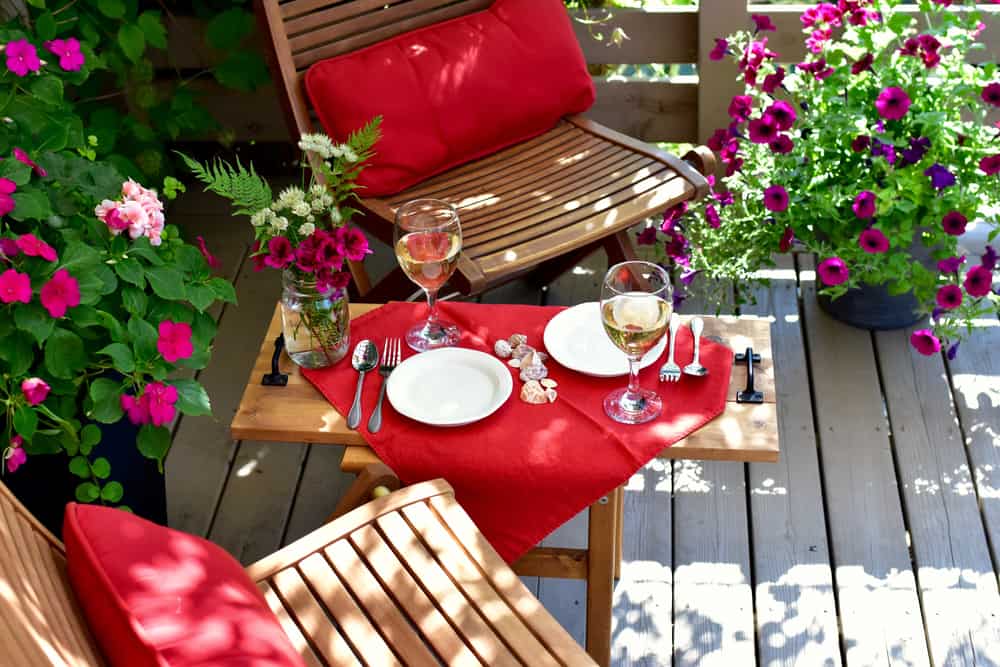Plants and flowers are happy to grow in all kinds of places if they get the sun and water they need. Translation? You don’t need a big yard to create a colorful oasis. Whether you live in an upper-level senior apartment or ground-floor villa, you can create an equally beautiful deck or patio garden using a variety of containers. And if you include a few vegetable and herb plants, it can even become a source of fresh ingredients.
Container gardening does take some maintenance to keep it tidy and weed-free, but the rewards are wonderful and the view from your window will be worth it! If you’re a first-time container gardener, here are a few green thumb tips to keep in mind.
Getting Started On Your Blossoming Patio Garden
Choosing Containers
When selecting planters for your patio garden, remember anything that holds soil and drains can be used. Be creative! Pottery, metal tubs, watering cans, window boxes, barrels, and hanging baskets all work well. For larger containers, consider placing them on wheeled platforms (available at any garden store)— to make them easier to move around. The experts also suggest simple pots for showy plants, and more decorative pots for more modest plants. If you hang pots, have a handy friend put them on pulleys so you can bring them down to your level for easier watering!
Choosing Plants
Before you head to the nursery, do a little online browsing to make a list of what you might like to buy. Annuals need to be replanted each year. Perennials grow back year after year. Native plants tend to be easier to grow and acclimate better. Pay attention to how the sun falls on your deck or patio – it will impact whether you choose shade lovers or sun seekers.
Annuals
The golden rule of planting a container with annuals is to include “a thriller, a spiller, and a filler.” The thriller is a focal point plant, something showy or tall for the center like a colorful geranium or fountain grass. The spiller is a plant that creeps or flows over the side like ivy. The filler plants add the fullness and color in and around the other plantings, like salvias, wax begonias. How many do you need? A container with an 18- to 24-inch diameter holds 5 or 6 plants.
Perennials
Yes, you can have a shrub as part of your deck or patio garden! Just choose dwarf varieties. Ask the nursery staff to direct you to the ones that are happy to live in containers. As alternatives, ornamental grasses, hostas, daylilies, sedge, lavender, and sedum all create lovely, easy-care patio garden displays … and they love living in containers.
Native Plants
Plants native to a particular region are easier to care for and typically flourish in their “home” environment. New Jersey boasts 2,000 native plants, according to the Native Plant Society of New Jersey. Purple coneflowers, trumpet honeysuckle, New England aster, and Black-Eyed Susan are just a few flower names you probably know. You can find a complete list of native New Jersey perennials, shrubs, trees, and more here.
More Tried & True Tips
- How Many Plants – Be sure to measure the diameter and height of each pot, so you know the amount of soil needed and the approximate number of plants required.
- Save That Plant Tag – Plant tags give you tons of good info about care, growth and more. Hang on to them and refer to them to help keep your plants happy and healthy.
- How Much Soil – The rule here is the more potting soil you use, the better the water retention. To maximize your soil’s capability, mix in slow-release organic fertilizer with your potting soil before you add your plant.
- Proper Drainage – Increase the drainage capability by punching or drilling slightly larger holes than the existing ones. The minimum size for a drainage hole is 1/2 inch in diameter for small or medium-sized pots. For larger containers, look for at least an inch in diameter.
- Light – People often wildly overestimate how much sun their containers get. While you can find a great plant for almost any amount of light, you have to know how much light your container will get before you choose your plants.
- Sun – To figure out how much direct light your container will get, place it where you want it and then time how long the sun hits it. You can also use a sun calculator to determine your sunlight.
- Feeding – Fertilize every week or two with a liquid natural fertilizer, like a fish emulsion or seaweed blend. Miracle-Gro is fine, too, but if you go with synthetic fertilizer, you’ll have to use that only. You can’t mix it with organic varieties.
- Watering – The best times to water are early in the morning or at sunset to allow for natural evaporation. Try not to let the soil dry out completely between watering. Mulching is helpful for water retention in larger pots.
- Pruning – Remove dried out leaves and spent blooms. Prune plants that get too long or out of control. Dig out plants that die or just don’t flourish. If you see crawling or flying plant pests, treat plants immediately.
Put Down Roots at Monroe Village & Live Your Best Life
Ready to plant your blossoming patio garden? Monroe Village has a choice of bright, welcoming independent living floor plans to choose from – and each of our one- and two-bedroom senior apartments include patios and/or decks. So let’s get growing! Fill out our contact request form and we’ll call you with all the details.



